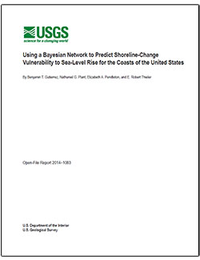Sea-level rise is an ongoing phenomenon that is expected to continue and is projected to have a wide range of effects on coastal environments and infrastructure during the 21st century and beyond. Consequently, there is a need to assemble relevant datasets and to develop modeling or other analytical approaches to evaluate the likelihood of particular sea-level rise impacts, such as coastal erosion, and to inform coastal management decisions with this information. This report builds on previous work that compiled oceanographic and geomorphic data as part of the U.S. Geological Survey’s Coastal Vulnerability Index (CVI) for the U.S. Atlantic coast, and developed a Bayesian Network to predict shoreline-change rates based on sea-level rise plus variables that describe the hydrodynamic and geologic setting. This report extends the previous analysis to include the Gulf and Pacific coasts of the continental United States and Alaska and Hawaii, which required using methods applied to the USGS CVI dataset to extract data for these regions. The Bayesian Network converts inputs that include observations of local rates of relative sea-level change, mean wave height, mean tide range, a geomorphic classification, coastal slope, and observed shoreline-change rates to calculate the probability of the shoreline-erosion rate exceeding a threshold level of 1 meter per year for the coasts of the United States. The calculated probabilities were compared to the historical observations of shoreline change to evaluate the hindcast success rate of the most likely probability of shoreline change. Highest accuracy was determined for the coast of Hawaii (98 percent success rate) and lowest accuracy was determined for the Gulf of Mexico (34 percent success rate). The minimum success rate rose to nearly 80 percent (Atlantic and Gulf coasts) when success included shoreline-change outcomes that were adjacent to the most likely outcome. Additionally, the probabilistic approach determines the confidence in calculated outcomes as the probability of the most likely outcome. The confidence was highest along the Pacific coast and it was lowest along the Alaskan coast.


